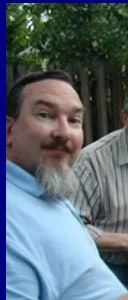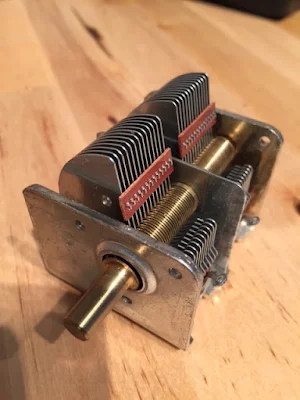Lately I found myself looking for something different to get involved in. Pete's conversion of his Ten-Tec commercial rig got me thinking about converting an old CB rig to 10 meter AM. I'm still planning on doing this, but noodling on this project got me thinking about AM in general. I had the DX-100 that John Zaruba K2ZA had given me (it was his dad's). I had it paired up with an old HQ-100 that I'd picked up in the Dominican Republic 20 years ago. (Looking at the old manual for this receiver, I realized that there is another reason why I feel so connected to it: it was built on West 34th St. in New York City, not far from where I was born.) On Veterans Day (November 11) I connected these two old Boatanchor veterans to my 40 meter dipole, rigged up a connector for my Astatic D-104, and fired up on 40 meter AM.
I had a blast! I found myself in contact with hams who are interested in the inner workings of their gear, guys who know which end of the soldering iron to grab. The DX-100 got great reports -- people said it sounded nice.
Sam K4NDY told me that his DX-100 had started out at 100 pounds, but that as time passed (and as he has gotten older) he noticed that it has somehow increased in weight!
Bill K8DBN was running a DX-60 and (like me) an HQ-100 (you see, we're no longer in Yaesu-Icom-Kenwood land!)
Mike KC2KJ was running a DX-100 and a Drake 2B. FB!
Steve W3DEF was on with his B&W 5100B.
Dave W3CRA was on from the Collins Radio Association. He restores Collins gear. When he told me the DX-100 sounded great, I knew that it really did.
Today I talked to Ed KA3PTX who has this really cool Boatanchor station:
And also today I had a great contact with Howard Mills W3HM, one of the greats in the world of radio restoration. Another fellow on frequency asked me to makes some critical comments on Howard's signal quality ("Does he have too much low frequency?") -- I refused, saying I was unworthy. (I did say that he sounded great -- he did.)
Anyway, I'm out of the rut. An added benefit is that this new (old) interest moves me even further away from microscopic SDR rigs, and closer than ever to the Hardware Defined, analog, discrete component, menu-free radio that I prefer. Check out the full schematic of a DX-100 -- simplicity, clarity, beauty:
I had been thinking vaguely about someday getting on 160 meters -- I've never used those frequencies. Yesterday I noticed that both the HQ-100 and the DX-100 cover this band. THE RADIO GODS HAVE SPOKEN!
















































